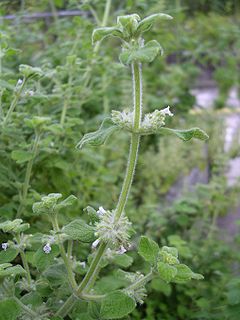Minthostachys mollis
Apparence
Minthostachys mollis
Inflorescences de Minthostachys mollis
| Règne | Plantae |
|---|---|
| Classe | Equisetopsida |
| Sous-classe | Magnoliidae |
| Super-ordre | Asteranae |
| Ordre | Lamiales |
| Famille | Lamiaceae |
| Genre | Minthostachys |
Minthostachys mollis ou muña est une plante médicinale endémique des Andes du Venezuela à la Colombie. C'est l'espèce la plus largement répandue du genre Minthostachys. Le nom de muña vient de la langue quechua, qui signifie menthum en latin (menthe). Elle est aussi connue sous les noms de tipo, tipollo ou poleo[4].
Liste des variétés
[modifier | modifier le code]Selon Catalogue of Life (23 septembre 2018)[5], World Checklist of Selected Plant Families (WCSP) (23 septembre 2018)[6] et Tropicos (23 septembre 2018)[1] :
- variété Minthostachys mollis var. hybrida Schmidt-Leb. (2008)
- variété Minthostachys mollis var. mandoniana (Briq.) Schmidt-Leb. (2008)
- variété Minthostachys mollis var. mollis
Selon The Plant List (23 septembre 2018)[2] :
- variété Minthostachys mollis var. mandoniana (Briq.) Schmidt-Leb.
Notes et références
[modifier | modifier le code]- (en) Cet article est partiellement ou en totalité issu de l’article de Wikipédia en anglais intitulé « Minthostachys mollis » (voir la liste des auteurs).
- Tropicos.org. Missouri Botanical Garden., consulté le 23 septembre 2018
- The Plant List (2013). Version 1.1. Published on the Internet; http://www.theplantlist.org/, consulté le 23 septembre 2018
- USDA, Agricultural Research Service, National Plant Germplasm System. Germplasm Resources Information Network (GRIN-Taxonomy). National Germplasm Resources Laboratory, Beltsville, Maryland., consulté le 23 septembre 2018
- Ben Alkire, « Tipo,minthostachys mollis (lamiaceae): an ecuadorian mint », Economic Botany, vol. 48, no 1, , p. 60-64 (DOI 10.1007/BF02901380)
- Catalogue of Life Checklist, consulté le 23 septembre 2018
- WCSP. World Checklist of Selected Plant Families. Facilitated by the Royal Botanic Gardens, Kew. Published on the Internet ; http://wcsp.science.kew.org/, consulté le 23 septembre 2018
Liens externes
[modifier | modifier le code]- Ressources relatives au vivant :
- (en) Référence Catalogue of Life : Minthostachys mollis (Benth.) Griseb. (consulté le )
- (en) Référence GRIN : espèce Minthostachys mollis Griseb. (consulté le )
- (en) Référence World Checklist of Selected Plant Families (WCSP) : Minthostachys mollis (Benth.) Griseb. (1874) (consulté le )
- (en) Référence NCBI : Minthostachys mollis (Kunth) Griseb. (taxons inclus) (consulté le )
- (en) Référence The Plant List : Minthostachys mollis (Benth.) Griseb. (source : KewGarden WCSP) (consulté le )
- (en) Référence Tropicos : Minthostachys mollis Griseb. (+ liste sous-taxons) (consulté le )

